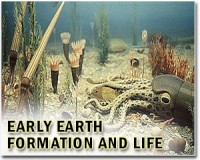 |
Washington DC (SPX) Sep 16, 2010 Recent puzzling observations of tiny variations in nuclear decay rates have led some to question the science of using decay rates to determine the relative ages of rocks and organic materials. Scientists from the National Institute of Standards and Technology (NIST), working with researchers from Purdue University, the University of Tennessee, Oak Ridge National Laboratory and Wabash College, tested the hypothesis that solar radiation might affect the rate at which radioactive elements decay and found no detectable effect. Atoms of radioactive isotopes are unstable and decay over time by shooting off particles at a fixed rate, transmuting the material into a more stable substance. For instance, half the mass of carbon-14, an unstable isotope of carbon, will decay into nitrogen-14 over a period of 5,730 years. The unswerving regularity of this decay allows scientists to determine the age of extremely old organic materials - such as remains of Paleolithic campfires - with a fair degree of precision. The decay of uranium-238, which has a half-life of nearly 4.5 billion years, enabled geologists to determine the age of the Earth. Many scientists, including Marie and Pierre Curie, Ernest Rutherford and George de Hevesy, have attempted to influence the rate of radioactive decay by radically changing the pressure, temperature, magnetic field, acceleration, or radiation environment of the source. No experiment to date has detected any change in rates of decay. Recently, however, researchers at Purdue University observed a small (a fraction of a percent), transitory deviation in radioactive decay at the time of a huge solar flare. Data from laboratories in New York and Germany also have shown similarly tiny deviations over the course of a year. This has led some to suggest that Earth's distance from the sun, which varies during the year and affects the planet's exposure to solar neutrinos, might be related to these anomalies. Researchers from NIST and Purdue tested this by comparing radioactive gold-198 in two shapes, spheres and thin foils, with the same mass and activity. Gold-198 releases neutrinos as it decays. The team reasoned that if neutrinos are affecting the decay rate, the atoms in the spheres should decay more slowly than the atoms in the foil because the neutrinos emitted by the atoms in the spheres would have a greater chance of interacting with their neighboring atoms. The maximum neutrino flux in the sample in their experiments was several times greater than the flux of neutrinos from the sun. The researchers followed the gamma-ray emission rate of each source for several weeks and found no difference between the decay rate of the spheres and the corresponding foils. According to NIST scientist emeritus Richard Lindstrom, the variations observed in other experiments may have been due to environmental conditions interfering with the instruments themselves. "There are always more unknowns in your measurements than you can think of," Lindstrom says. R.M. Lindstrom, E. Fischbach, J.B. Buncher, G.L. Greene, J.H. Jenkins, D.E. Krause, J.J. Mattes and A. Yue. Study of the dependence of 198Au half-life on source geometry. Nuclear Instruments and Methods in Physics Research Section A: Accelerators, Spectrometers, Detectors and Associated Equipment. doi:10.1016/j.nima.2010.06.270
Share This Article With Planet Earth
Related Links National Institute of Standards and Technology (NIST) Explore The Early Earth at TerraDaily.com
 Oxygen 'oases' led to all life on Earth
Oxygen 'oases' led to all life on EarthTempe, Ariz. (UPI) Aug 23, 2010 The presence of oxygen in Earth's atmosphere came from ancient microbes inhabiting "oxygen oases" in the oceans billions of years ago, U.S. researchers say. Two and a half billion years ago the atmosphere contained almost no oxygen, Arizona State University scientists say, and life as we know it was not possible in an environment devoid of oxygen. Around that time, microbes known ... read more |
|
| The content herein, unless otherwise known to be public domain, are Copyright 1995-2010 - SpaceDaily. AFP and UPI Wire Stories are copyright Agence France-Presse and United Press International. ESA Portal Reports are copyright European Space Agency. All NASA sourced material is public domain. Additional copyrights may apply in whole or part to other bona fide parties. Advertising does not imply endorsement,agreement or approval of any opinions, statements or information provided by SpaceDaily on any Web page published or hosted by SpaceDaily. Privacy Statement |